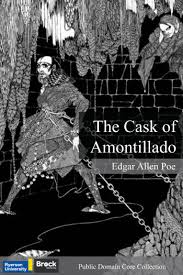Setting the Stage for Vengeance
In the dimly lit streets of pdf of the short story of the cask of amontillado carnival-time Italy, Edgar Allan Poe masterfully crafts a tale of revenge. The story’s narrator, Montresor, harbors a deep-seated hatred for the unsuspecting nobleman Fortunato, who has wronged him. Through carefully chosen words and calculated actions, Montresor lures his victim into the damp catacombs beneath his palazzo. Meanwhile, the festive atmosphere above ground creates a stark contrast to the sinister plot unfolding in the darkness.
The Art of Deception
Furthermore, Montresor demonstrates remarkable psychological manipulation as he exploits Fortunato’s pride in wine connoisseurship to devastating effect. The protagonist dangles the prospect of rare Amontillado sherry before his prey like a skilled fisherman with bait. Consequently, Fortunato’s eagerness to prove his expertise blinds him to the obvious warning signs of impending doom. The carnival setting provides the perfect cover for Montresor’s diabolic scheme to unfold without suspicion.
Symbolism in the Depths
Subsequently, every element of the story’s setting carries deep symbolic meaning that enriches the narrative’s dark themes. The winding catacombs represent the twisted nature of Montresor’s revenge plot against his unsuspecting victim, Fortunato. Moreover, the Montresor family coat of arms, featuring a serpent being stepped on, foreshadows the story’s events. The damp air and nitre-covered walls create an atmosphere of decay that mirrors the corruption within Montresor.
The Psychology of Revenge
Throughout the narrative, Poe expertly reveals the complex psychological aspects driving Montresor’s calculated pursuit of vengeance. The protagonist’s methodical planning and execution of his revenge demonstrate a chilling level of emotional detachment and precision. Meanwhile, his polite demeanor and friendly conversation with Fortunato mask the depths of his hatred and malice. The story explores how a seemingly civilized person can harbor such profound darkness within their soul.
Building Tension Through Dialogue
Additionally, the conversation between Montresor and Fortunato serves to heighten the dramatic tension throughout their fateful journey. Each exchange between the two characters carries double meaning, with Montresor’s words containing subtle hints of his intentions. The repeated references to Fortunato’s health take on an increasingly sinister tone as they descend deeper. Their dialogue masterfully illustrates the power dynamic between predator and unsuspecting prey in this deadly game.
The Role of Pride
Subsequently, pride emerges as a central theme that drives both characters toward their respective fates in the story. Fortunato’s excessive pride in his wine expertise makes him vulnerable to Montresor’s carefully laid trap and manipulation. Meanwhile, Montresor’s wounded pride from past insults fuels his unquenchable thirst for revenge against his former friend. The fatal interplay between these two forms of pride leads inevitably toward the story’s horrific conclusion.
Architectural Symbolism
Moreover, the architectural details of the catacombs serve as powerful metaphors for the psychological descent into darkness and madness. The narrowing passageways mirror the constricting options available to Fortunato as he approaches his gruesome fate below. The piles of bones and ancient family crypts remind readers of mortality and the weight of history. Each step deeper into the vaults represents another step toward Fortunato’s inevitable doom at Montresor’s hands.
The Perfect Crime
Furthermore, Poe crafts a murder that is methodically planned and executed with spine-chilling precision and attention to detail. The chains, tools, and building materials have all been prepared in advance for this moment of revenge. Montresor’s servants have been deliberately sent away, ensuring no witnesses remain to observe his dark deed. The carnival celebrations above provide convenient cover for any suspicious sounds from the catacombs below.
Elements of Gothic Horror
Consequently, the story incorporates classic elements of Gothic horror that heighten its psychological impact on readers and listeners. The dank underground setting creates an atmosphere of claustrophobia and impending doom for the unfortunate Fortunato. Dark passages, flickering torchlight, and the ever-present threat of being buried alive prey upon primal human fears. The combination of psychological and physical horror makes this tale particularly effective and memorable.
The Question of Justice
Nevertheless, Poe leaves readers to grapple with complex questions about justice, revenge, and the darkness within human nature. The story provides no clear justification for Montresor’s extreme actions against his supposed friend Fortunato. The protagonist’s reliability as a narrator becomes increasingly questionable as the tale unfolds toward its conclusion. Readers must decide whether this was an act of justice or simply cold-blooded murder in disguise.
Narrative Structure
Additionally, Poe employs a framed narrative structure that adds layers of complexity to this seemingly straightforward revenge tale. The story begins with Montresor addressing an unknown listener about events that occurred fifty years in the past. This narrative distance creates uncertainty about the reliability of Montresor’s account of these tragic events. The temporal gap between the crime and its retelling raises questions about memory and motivation.
Legacy and Impact
Subsequently, The Cask of Amontillado has profoundly influenced the development of psychological horror in literature and popular culture. The story’s exploration of revenge, pride, and madness continues to resonate with readers across generations and cultures. Modern authors frequently reference and draw inspiration from Poe’s masterful handling of psychological horror themes. The tale’s impact on the genre of horror literature remains significant more than 150 years after publication.
Conclusion:
In conclusion, The Cask of Amontillado stands as a masterpiece of psychological horror and carefully calculated revenge. Through masterful use of setting, symbolism, and characterization, Poe creates an unforgettable descent into human darkness. The story’s themes of pride, revenge, and justice continue to provoke discussion and analysis among readers. Finally, this chilling tale serves as a reminder of humanity’s capacity for both sophisticated reasoning and primitive vengeance.
Author’s Note: This analysis explores Edgar Allan Poe’s short story The Cask of Amontillado, examining its themes, structure, and enduring impact on literature. The article combines textual analysis with broader interpretative elements to illuminate the story’s significance and psychological complexity.
